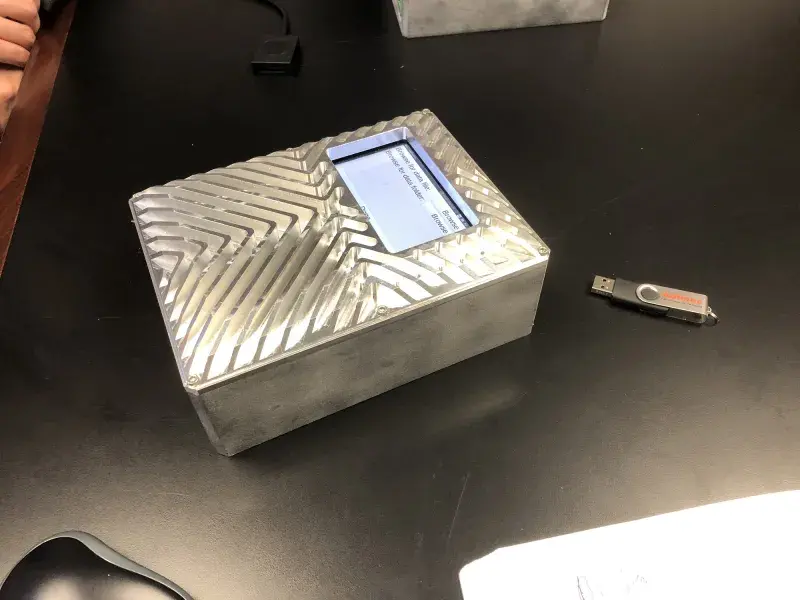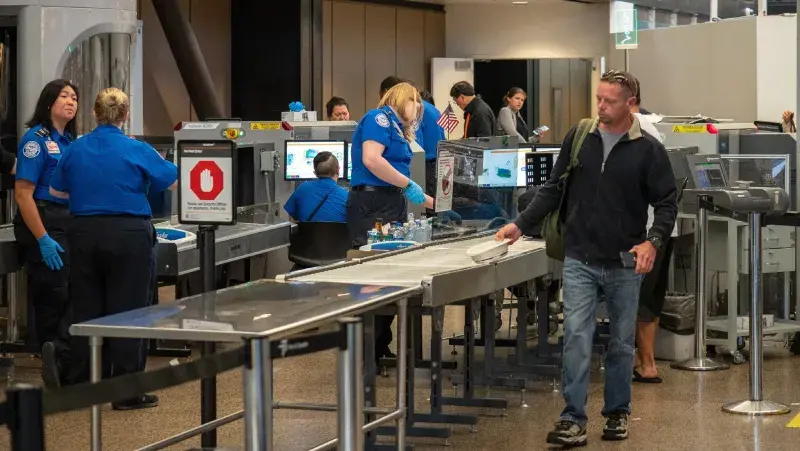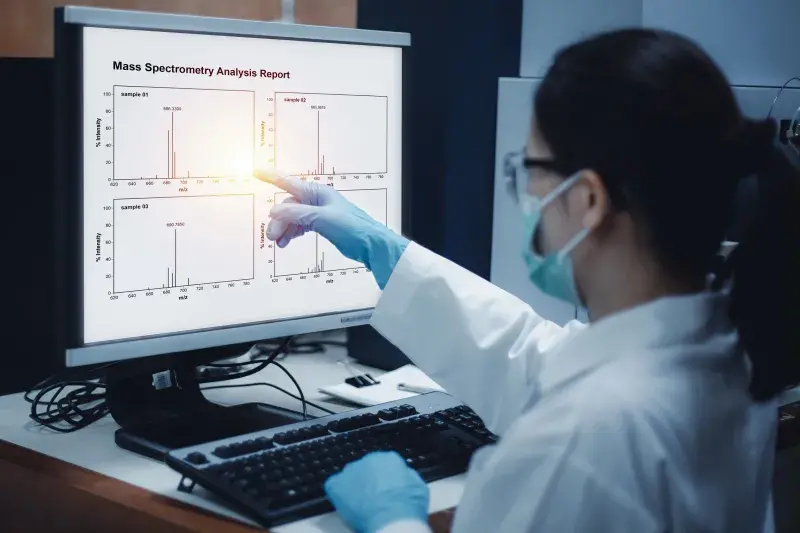Harnessing the power and possibilities of artificial intelligence (AI) and machine learning (ML) and applying these emerging capabilities to the Department of Homeland Security (DHS) mission has been, and will continue to be, a high priority for the Science and Technology Directorate (S&T). One way S&T is demonstrating this commitment to applying emerging technologies to pressing national threats is by investing in the development of AI/ML technologies. Specifically in this case, the funding is directed at AI/ML that could soon be used to identify dangerous compounds, like those found in explosives and narcotics.

When the DHS Small Business Innovation Research (SBIR) Program released a solicitation back in FY2020, under the topic “Machine Learning Module for Detection Technologies,” the goal was to develop innovative solutions that would ultimately provide DHS operational components with an enhanced ability to identify new threats at aviation checkpoints. In the spring of 2021, following their 6-month Phase I awards to demonstrate concept feasibility, Physical Sciences Inc. (PSI) and Alakai Defense Systems, Inc. (Alakai) were each awarded a $1 million, 24-month SBIR Phase II contract. These awards further lean into the ultimate goal of developing advanced AI/ML-based detection algorithms that can shorten the timeline for deployment of capabilities able to identify threats in the field. The research and development (R&D) being done is important because it addresses a capability gap in the detection of certain types of new threats. S&T believes that AI/ML solutions can help close that gap.

According to Thoi Nguyen, program manager for S&T’s Next Generation Explosives Trace Detection Program, “When the intel, special ops, or law enforcement communities find a new threat, maybe a new explosive compound, the threat is validated and prioritized according to urgency levels. DHS S&T is then tasked to develop an R&D solution to detect and identify the threat. Once the solution is tested, evaluated, and verified that it meets DHS detection requirements, DHS Components go through a lengthy DOTMLPF (Doctrine, Organization, Training, Materiel, Leadership and Education, Personnel and Facilities) process to acquire and deploy the solution. At the end of this process, the chemical ‘signature’ of the threat is uploaded to DHS equipment at airport checkpoints.”

However, adding a new compound to the existing identification library of threat compounds historically has been a slow, meticulous, and labor-intensive process. This can result in a capability gap for updating the database.
The challenge S&T posed with this funding award is to see if an AI/ML solution can significantly expedite the process of updating a detection library, without the intensive human labor.
One of the ways that dangerous compounds are identified at checkpoints is with Raman Spectroscopy. This chemical analytical technique fires a laser at a vaporized and ionized sample that was swabbed from a traveler, or into an object like a closed bottle of liquid. The laser will excite the molecules it encounters in the target, causing them to vibrate. Every type of molecule has its own distinct vibrational frequency. The spectrometer will detect those vibrational frequencies and chart them on a graph. The chemical signature is determined by where specific peaks are found on the graph and the intensity, height, and width of those peaks. Then the system searches the chemical signature library to find a match. If the sample matches an explosive in the database, the alarm is sounded.
So, what’s the problem? “The bottleneck is not in the intel process, the bottleneck is in the R&D process and how to add that new threat intel, the new chemical signature, into the library so we can catch the bad guys,” said Nguyen. “That’s where the AI/ML that our small business partners are developing fits into the equation.”
“We love small businesses because they’re innovative and nimble,” said SBIR Program Director Dusty Lang. “The SBIR program allows us to absorb the risk by funding multiple Phase I proposals to explore feasibility, then move forward to Phase II with the best solutions for DHS needs.”
Traditionally, when a new threat compound is introduced into the library, scientists and contractors are brought in to manually create a new classification or channel for it. At that point, the tedious work to enter all the spectrographic characteristics of the chemical into the library begins. The programing of the chemical traits for the channel must be extremely precise to ensure they get the highest Probability of Detection (PD) and the lowest Probability of False Alarm (PFA) when the library is queried with a sample at a checkpoint.
One of the complicating factors for achieving high PD and low PFA is that the software analyzing the compound must be able to see through the background noise in the sample and identify the compound for what it really is.
“For example, pure TNT from a lab may appear different from TNT in a real-world scenario because there may be additives to the TNT, or there may be other environmental interference. So, even though it might have spectrographic peaks at the right places, they might be somewhat obscured by these other excited molecules and their signatures. If you’re creating a TNT channel, we would have to account for myriad factors. That’s what takes so much time and that’s where accuracy is so important. It has to be calibrated perfectly. What we're trying to do here with the AI and the ML is that we want to bypass that slow process.”

The first part of that bypass is training the AI to recognize a specific compound. However, the AI can’t teach itself. It still needs to be taught how to do it. The ML-based detection algorithm starts as a blank sheet, and it must be taught which peaks on the graph represent which chemicals. “It’s like teaching a child what sugar tastes like,” said Nguyen. “When you taste this, that is sugar. That’s what we call sweet. And this is sugar with a little bit of lemon. You taste the sour lemon, but it’s still sugar. It’s the same thing with teaching the AI to not get confused by the background noise.”
In Nguyen’s example, the important thing for the child to understand is that the sample is still sugar, and the lemon is just an additive. In the explosive detection world, that lemon might be a fuel added to TNT to make it more powerful. Making sure that the explosives detection algorithm is smart enough to determine that the TNT is mixed with another fuel compound is incredibly important.
That brings us to the second part, which is validation. Once the AI is taught the signature characteristics of the compound, and potential noise distractions have been accounted for, the AI is evaluated for accuracy by running tests designed to trick it. Chemicals are added to the original compound in attempts to shield or mask the spectrographic signature behind other noise.
Nguyen emphasizes the importance of this part, adding that, “We don’t just trust AI completely. We say, ‘trust, but verify,’ to see whether or not the alarm that was just triggered complies with our understanding of how the vibration of the molecules we are testing should present themselves.”
For a limited set of explosives, S&T demonstrated that the AI/ML solution identified explosives with very high PD, yet low PFA—a major success by itself. Even more remarkable is the way that this AI/ML solution has closed the critical time capability gap.

“What traditionally can take as many as one to two years, the AI/ML that our partners developed can now learn, classify, and upload new threats to the library in a matter of days or weeks,” said Nguyen. “That has significant real-world impact. And I want to make sure that we give credit to SBIR, because without their collaboration, funding and support, this project would never have happened.”
SBIR’s Lang added, “These two companies, PSI and Alakai, demonstrate the impact small business can have and why we are always working to strengthen the SBIR reach and support. It is very rewarding to be able to work with program managers like Thoi to facilitate the connections of ideas and needs.”
This round of Phase II funding from the SBIR Program resulted in confirmation that AI/ML has a place in the future of explosive detection. The shortened deployment cycle to chemical libraries in the field, coupled with maintaining the high PD and low PFA, is something that human hands can’t match. That’s the power of trustworthy AI/ML and that’s what S&T is looking to leverage to further secure the nation.
In terms of looking back on the work that has been developed under the program, Nguyen finished up stating, “It was a success beyond our imagination.”
In the future, AI/ML modules will be tested and evaluated at the U.S. Army's Chemical Biological Center. The goal there will be to determine compatibility between three types of Raman Spectrometers and their interoperative capabilities.
For additional information regarding S&T’s explosive trace detection work and the SBIR program, contact stmedia@hq.dhs.gov.
